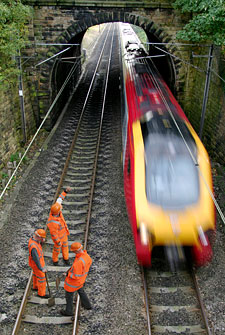The corridor of uncertainty
Contrary to popular belief there are three main options for a safe system of work - red zone, green zone and grey area. The latter is little understood but frequently applied. There’s no mention of it in the Rule Book. But if you take to the rails after nightfall, you’ll find many trackworkers ‘on the tools’ in the corridor of uncertainty - close to the sleeper ends of an open line with no legitimate form of protection.
It’s a product of two basic failings: the inability of many people to map their procedural knowledge of the red/green concept onto a real track layout, and the absence of a quick and simple means of providing a warning during darkness. Both drive people towards, and often beyond, the boundaries of safety.
Let’s assume we’re changing a sleeper on the Down line which is blocked courtesy of a T2. Trains are still running on the adjacent Up line. The widely-held perception that blocking a line inevitably leads to a green zone is simply not correct (except on a single line). It all depends on the work involved and ours requires access to the six-foot between the two tracks.
No problem in daylight - we appoint a lookout and alert the group to passing trains, although I know of one COSS who was taken to task by an HMRI inspector for doing just that. It wasn’t the COSS who was ignorant. But there’s a big fly in our ointment - we’re resleepering in the dark and the red zone route with lookouts is barred by the rules. Fenced green, ATWS and LOWS are logistically impractical. Pee Wee is dead and buried. There’s no TOWS.
|
 |
|
Separated green zones:
are they really safe havens?
|
We’re left with one option - the protective cocoon of a separated green zone with a barrier of fresh air patrolled by a site warden. This might pass muster in the sterile world of the railway theorist but muddy reality introduces many variables - people, work, tripping hazards, distractions and, not least, trains passing without warning just feet away. A platoon of site wardens isn’t going to stop someone taking an errant diversion towards the neighbouring line and if this coincides with the midnight express emerging from the gloom, the unfortunate individual can pay a very high price. Mark Falivena discovered this at Desborough.
|
| This might pass muster in the sterile world of the railway theorist but muddy reality introduces many variables... |
|
In practice, we can’t resleeper in a separated green zone - the ‘protected’ area just isn’t big enough - but it’s the only safe system which comes close without the benefit of an all-lines block. Our work planner - like legions of others - has ticked this box and left the poor COSS to pick up the pieces. This means relying on hope and prayer. Without doubt, it’s a conspiracy of circumstance which will be repeated at many sites across the network tonight.
Erecting fences, putting up lights, positioning speed boards and a host of other routine activities - in darkness, all can involve brief forays into no-man’s land which are impractical within the rules unless we can bring the train service to a standstill.
It’s a difficult one to solve so the industry hasn’t bothered. But separated green is fundamentally flawed - it doesn’t prevent an encounter with passing trains, neither does it warn of their approach. As such, it offers all the protection of a chocolate fireguard and the sooner it’s relegated from the Rimini Premier League the safer people will be.
Story added 1st December 2005
|